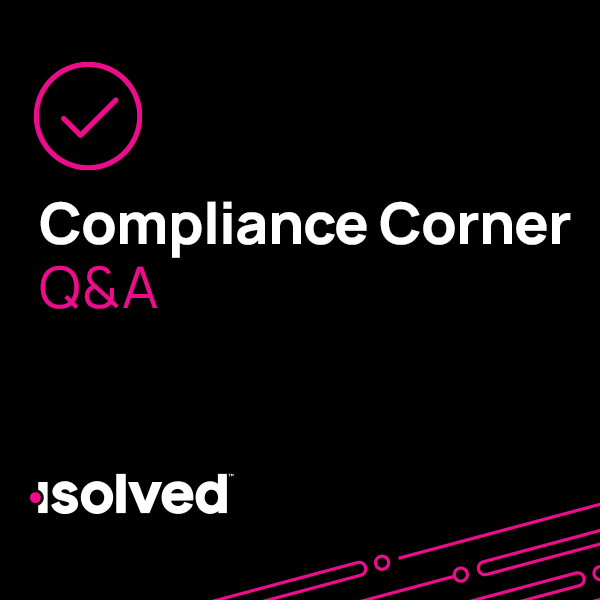Compliance Corner: Q&A on Payroll Best Practices for a Compliant Year-End
Tuesday November 29th, 2022
Estimated time to read: 3 minutes, 15 seconds

The end of the year is almost here, and it's time to wrap up payroll. Every HR rep wants to stay compliant at this very pivotal time of year. HR reps may be contemplating what to do in order to knock it out of the park and stay compliant to start the New Year off right.
In this month's Compliance Corner blog, isolved's HR Services Manager Kayla Miller answers questions about best practices for end of year payroll and how to stay compliant.
Q. What can HR/Payroll specialists do to prepare for end of year?
A. HR/Payroll specialists should spend time looking back and forward to make sure the turn of the calendar does not hold any unnecessary surprises. They can rely on year-end webinars and checklists to review last year’s process to see how it went, identify any issues to correct, and prepare for any evolving legal changes.
Q. How can HR/Payroll specialist ensure payroll compliance?
A. Payroll specialists need to be nimble in their knowledge and documentation. Laws change, and many have a January 1 effective date, so keeping on top of changing requirements and making sure they are handled timely is critical. Some changes should be anticipated, like changes to HSA contribution rates, Social Security maximums, 401(k) and FSA Limits. Those tend to vary from year-to-year. Likewise, state unemployment contribution rate changes are typical. Some things are less obvious, such as workers compensation classifications or changes to taxable fringe benefit rules. To maintain compliance, payroll specialists need to make sure their legal resources are dependable and timely.
Q. What are a few best practices for end of year payroll?
A. In planning for and executing a successful year-end, start by getting into a “look back” and “look forward” frame of mind early – don’t wait until the final payroll.
Some best practices in “looking back” include:
- Make sure data is accurate in the system so that W-2s and ACA reporting can be completed efficiently (send reminders to employees early and often to make sure Social Security n umbers, name and address are correct).
- Make sure benefit balances are accurate. Any “use it or lose it” benefits should be identified, and balances should be communicated, if possible. Confirm sick time, vacation and PTO carry-over amounts are accurate. Communicate carry-over rules and balances and make sure to tell employees where they can be found.
- Check GTL calculations to see if you have been taxing employees throughout the year or if you need to add those amounts to the final payroll.
- Check 401(k) and HSA contributions to make sure maximums have not exceeded the legal limit.
Some best practices in “looking forward” include:
- Confirm payroll schedule for the upcoming year, including payroll processing deadlines.
- Confirm holiday schedules (and adjust deadlines, if affected). Make sure vacation calculations for the new year are going to accrue accurately. Pay close attention to individuals increasing on or after the first of the year to make sure they receive new accrual rates timely.
- Review any applicable law changes affecting payroll. For example, this is the time to assure hourly employees will receive at least minimum wage for the upcoming year and that exempt employees are making the required minimum monthly amount in order to maintain exempt status.
- Send a reminder to your employees regarding submitting a new W-4 for the new year. Employees who are currently claiming exempt from withholding must submit a new W-4 by February 15 to maintain that status. Employers are required to begin withholding federal tax for those employees who fail to provide a new W-4 by that date. Also, any employees who have experienced a life event may need to submit a new W-4 due to the change in number of allowances.
Finally, some best practices to prepare for the final payroll include:
- Confirm payroll schedules and deadlines for the last check of the year, especially given shortened holiday weeks or potential holiday shutdowns.
- When processing bonuses, make sure they are being taxed correctly. Plan documents should be reviewed to make sure 401(k) contributions are withheld appropriately.
- If cash value holiday gifts are going to be distributed, make sure taxation is set up correctly. It can be particularly time consuming if the company is planning to gross up taxes on the bonus, so plan accordingly.
- Make sure any last-minute manual checks or adjustments are accounted for in the system before year end.
Q. Are there any end-of-year actions that frequently get missed?
A. Typical missed items include:
- Collecting and recording taxable fringe benefits (including personal use of company vehicles, non-qualified moving expenses, company-provided transportation/parking, tuition reimbursement)
- Assuring who is going to handle tax recording and W-2 preparation for third party sick pay.
- When reviewing the payroll schedule for the next year, pay particular attention to the number of payrolls, especially for biweekly employees so that the correct annual gross pay is made for the year (e.g., 26 pay periods versus 27)

About Kayla:
Kayla serves as an HR Services Manager for isolved, bringing more than a decade of payroll and benefits administration experience to the team. In Kayla’s current role she manages a group of Payroll and Benefits specialists on the Custom HR Services team which is responsible for providing day to day payroll administration, benefits administration, and overall HR support to various clients.
*This blog is not legal advice. Please seek proper legal advice.
